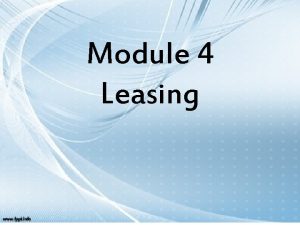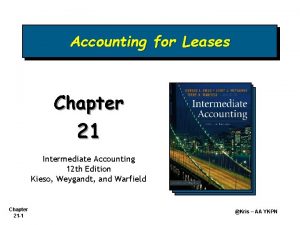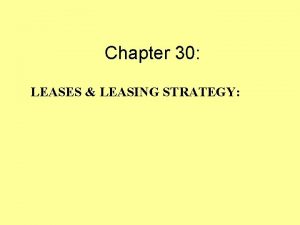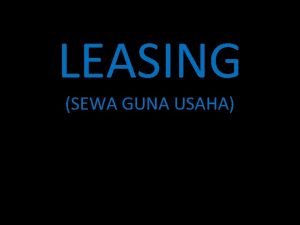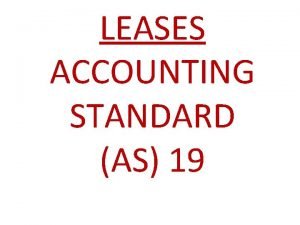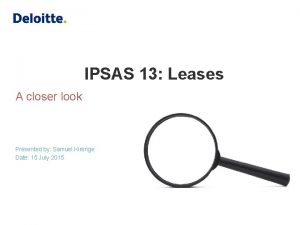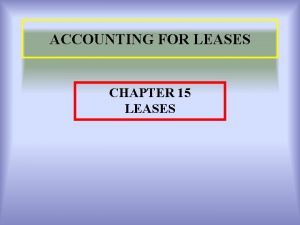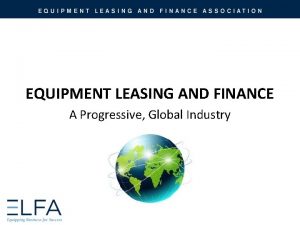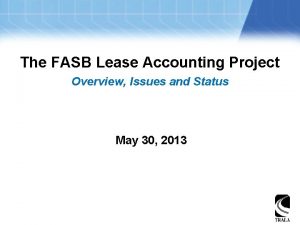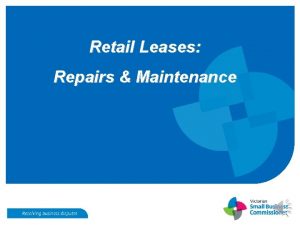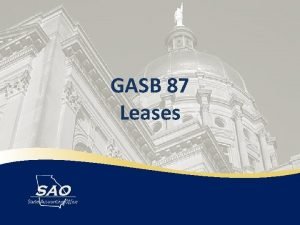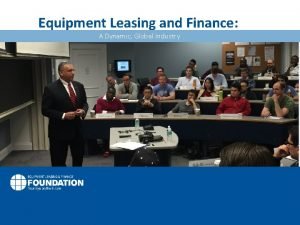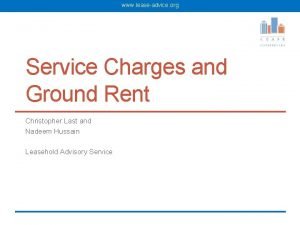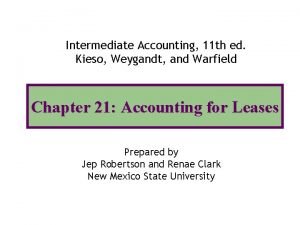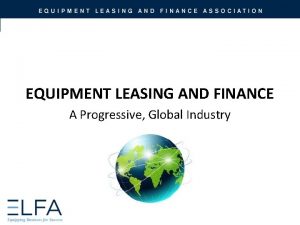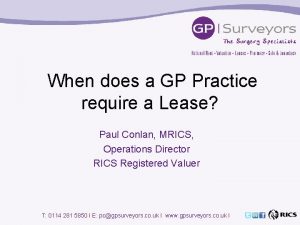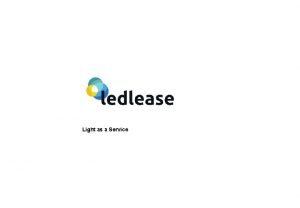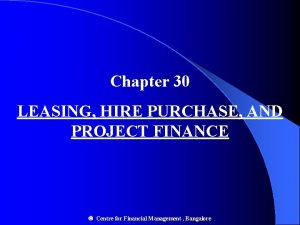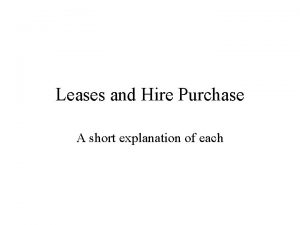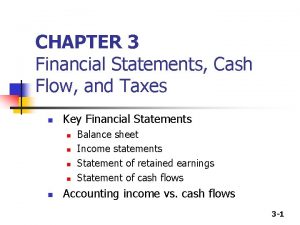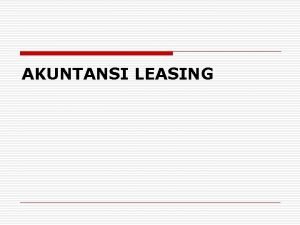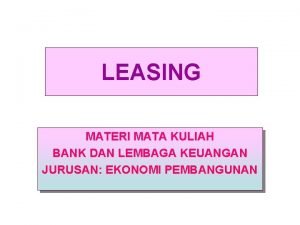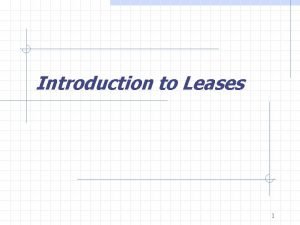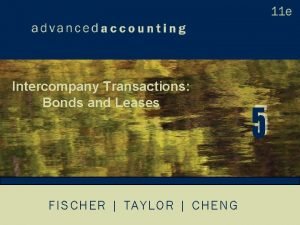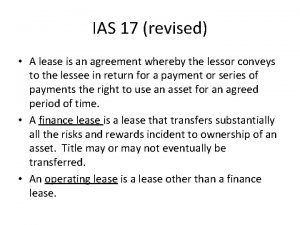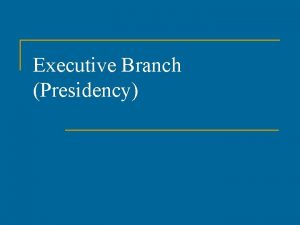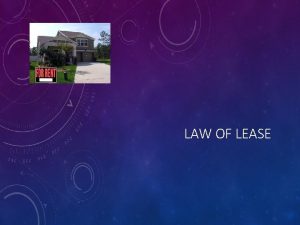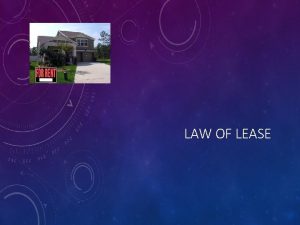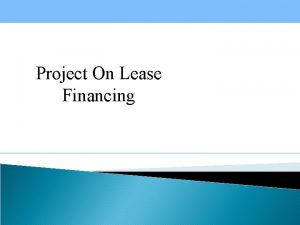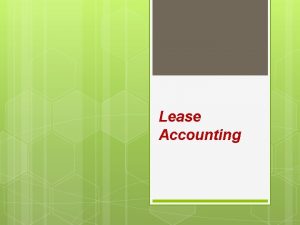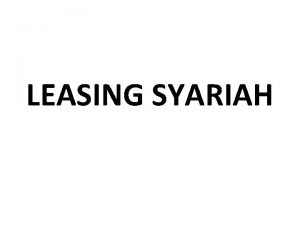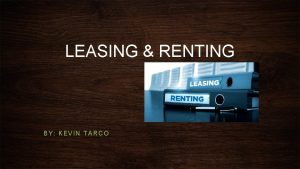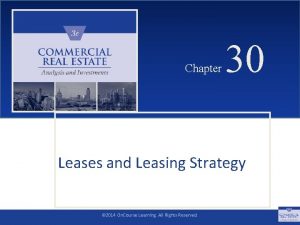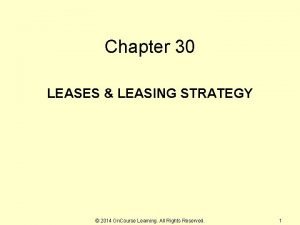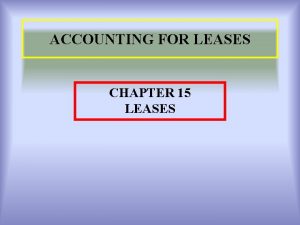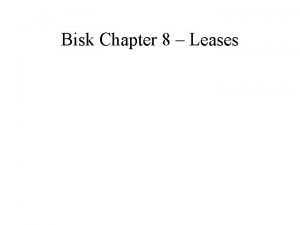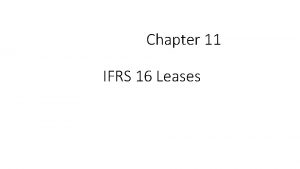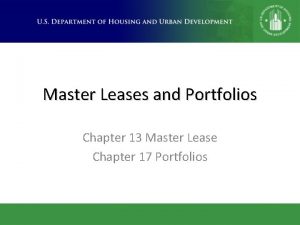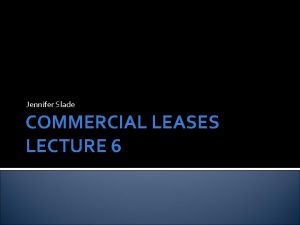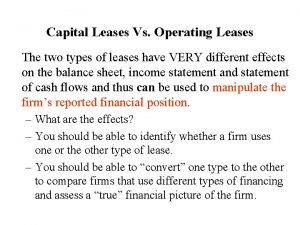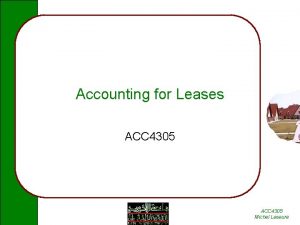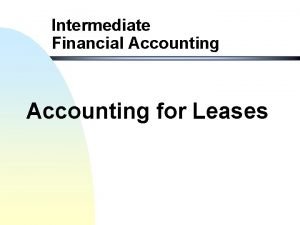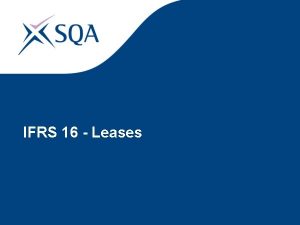Chapter 30 LEASES LEASING STRATEGY 30 2 LEASE












































- Slides: 44

Chapter 30: LEASES & LEASING STRATEGY:



30. 2 LEASE CHARACTERISTICS AFFECTING VALUE OR RENT: • Space - location, size, shape, adjacent uses (synergy, externality). • Lessee - credit quality, prestige, externalities. • Date & Term (length of period covered). • Rent terms. • Concessions - e. g. , free rent, tenant improvement allowance (TI), . . . • Covenants (who is responsible for what). • Sublet (assignment) rights - permitted unless explicitly negated in contract. • Options - e. g. , renewal, cancellation, 1 st refusal, etc.










BROADER LEASING STRATEGY CONSIDERATIONS (aka: things left out of the effective rent calculation): 30. 4. IMPLICATIONS FOR OPTIMAL TERM LENGTH & THE TERM STRUCTURE OF RENT. . . Should you always choose the lease with the best effective rent? . . . Answer: No! So, What's left out of the effective rent calculation ? . . .

30. 4. 1) Interlease risk. . . Has risk been included at all in the effective rent calculation? … (It depends on the “k” value that is used. ) If “k” based on tenant's borrowing rate, then risk factors included in loan OCC will have already been included and accounted for, that is, risk within the lease (relevant to “intra-lease discount rate”), including: 1. Interest rate risk 2. Tenant default risk (Note: Default risk to the lessor may be less than default risk to lender: Landlord can lease space to another tenant. ) However, tenant's borrowing rate will not well reflect some other sources of risk for landlord (and tenant), in particular, sources which influence risk between leases (relevant for inter-lease discount rate)…

Sources of inter-lease risk (in OCC): • Space market risk (uncertainty re future contract rental rate in lease). • Term structure of interest rates in bond market (duration between leases > duration within leases, due to level CFs in leases, no “balloon”, & bond mkt yield curve usually rises with duration, reflecting “interest rate risk” & “preferred habitat”). • Note: The former is more important than the latter. Implication: longer-term leases reduce risk in a way that is not reflected in the effective rent calculation: • Cet. Par. , landlord prefers longer-term lease at same eff. rent, or is willing to accept lower eff. rent for longer-term lease, relative to a projection of what the future short-term (or "spot") rents will be. • Tenant feels same way.



Implication for landlord lease term indifference rents: If future spot rents are projected to remain constant at the current level, then the indifference rent will assume a downward-sloping curve as a function of the lease term…

What about tenant’s perspective? . . . Tenants preferences are symmetric to landlords: • At same rent, tenants prefer shorter-term leases (by same dollar amount as landlords prefer longer-term leases). PV of perpetual stream of rent payments is same to tenant as to landlord (only it’s a cost instead of a value: negative instead of positive). So tenants have same downward-sloping lease term indifference rent curve (with constant spot rents)…

Example: • Tenant produces widgets which are sold for $1 each with a variable production cost of $0. 50 each. • Expected production is 1000 widgets per year in perpetuity. • Opportunity cost of capital for widget production investment (apart from rent) is 10% per year. If rent is $100/yr then value of tenant firm is: V = PV(widget net income) – PV(rent) = $500/0. 10 – PV(rent) = $5000 - $833 = $4, 167, if 1 -yr leases @$100/yr = $5000 - $954 = $4, 046, if 10 -yr leases @$100/yr Tenant prefers short-term leases. èEquilibrium rent term structure that would allow both landlords and tenants to be indifferent across leases of different term lengths is downward-sloping. Tenant firm value: V = $5000 - $833 = $4, 167, if 1 -yr leases @$100/yr = $5000 - $833 = $4, 167, if 10 -yr leases @$87. 32/yr


If space market expectations are conflicting and not reconcilable, then agreement will be facilitated by reducing the lease term length, thereby reducing the impact of future changes in market rents on the opportunity cost of the lease, and providing more flexibility to either side to take advantage of favorable developments in the rental market.



General “bottom line” from flexibility considerations: Shorter lease terms increase flexibility value (though mitigated by explicit lease options and sublease rights).






The art of tenant mixing extends not only to matching the right sort of anchors together with the right sort of non-anchor tenants, but also includes optimal mixing, matching, and location of the non-anchor stores. Use of short lease terms and/or renewal and cancellation options on both sides is common in many retail centers to enable tenant mix to be constantly optimized in the dynamic retail market where flexibility is particularly important.

Heavy solid line = Tenant store operating margin Light straight line = Fixed rent Dashed line = Percentage rent


30. 5. 3) Why concessions? . . . e. g. , why does the $20/SF Lease "A" not simply charge the tenant $15. 44/SF every year for 5 years starting immediately, rather than take no cash flow at all for the first year? . . . Recall: Reasons:

30. 5. 3) Why concessions? . . .

30. 5. 3) Why concessions? . . .







 Operating lease vs finance lease
Operating lease vs finance lease Residual in accounting
Residual in accounting Chapter 21 accounting for leases kieso terjemahan
Chapter 21 accounting for leases kieso terjemahan Leasing strategy
Leasing strategy Leases adalah
Leases adalah As 19 accounting standard
As 19 accounting standard Ipsas 13 leases
Ipsas 13 leases Interest rate implicit in the lease formula
Interest rate implicit in the lease formula Pv of minimum lease payments
Pv of minimum lease payments Trac leases asc 842
Trac leases asc 842 Ias 17 leases
Ias 17 leases View dhcp leases watchguard system manager
View dhcp leases watchguard system manager Gaap accounting for trac leases
Gaap accounting for trac leases Ifrsbox leases
Ifrsbox leases Section 52 retail leases act
Section 52 retail leases act Gasb 62 leases
Gasb 62 leases Operating lease
Operating lease Ias17
Ias17 Www.lease-advice.org
Www.lease-advice.org Pengertian finance lease
Pengertian finance lease Intermediate accounting
Intermediate accounting Ifrs 16 ias plus
Ifrs 16 ias plus Equipment leasing and finance industry snapshot
Equipment leasing and finance industry snapshot Gp lease renewals
Gp lease renewals Contract and lease management sap
Contract and lease management sap High eggs hearse sized hay lee
High eggs hearse sized hay lee Crane night vision lease program
Crane night vision lease program Window jokes
Window jokes Private definition
Private definition Led lease
Led lease Rules of ijarah
Rules of ijarah Sanderson commercial land for lease
Sanderson commercial land for lease Finance lease vs hire purchase
Finance lease vs hire purchase Troubleshooting always on availability groups
Troubleshooting always on availability groups Hire purchase accounting treatment
Hire purchase accounting treatment Progressive lease pmts
Progressive lease pmts Caecilia widi
Caecilia widi Lease o
Lease o Whats the lend lease act
Whats the lend lease act Operating lease journal entries
Operating lease journal entries Materi leasing bank dan lembaga keuangan
Materi leasing bank dan lembaga keuangan Percentage rent natural breakpoint
Percentage rent natural breakpoint Intercompany lease
Intercompany lease Ias 17
Ias 17 President formal and informal powers
President formal and informal powers
